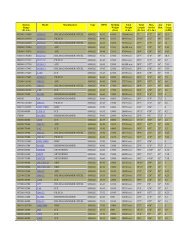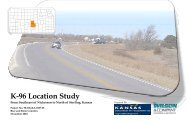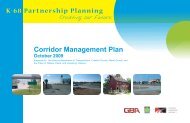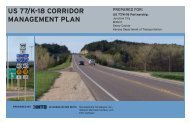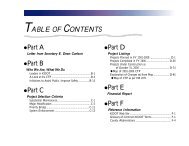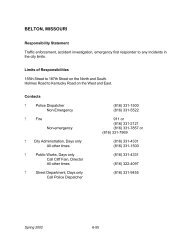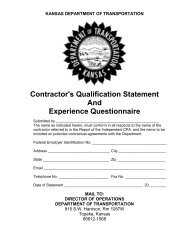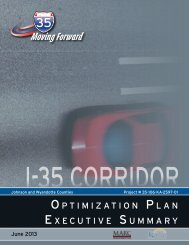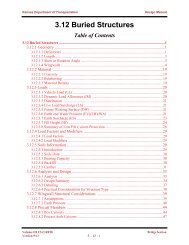KANSAS MOTOR VEHICLE ACCIDENT REPORT CODING MANUAL
KANSAS MOTOR VEHICLE ACCIDENT REPORT CODING MANUAL
KANSAS MOTOR VEHICLE ACCIDENT REPORT CODING MANUAL
You also want an ePaper? Increase the reach of your titles
YUMPU automatically turns print PDFs into web optimized ePapers that Google loves.
disappear and must be photographed as soon as possible. Other evidence like gouges will last<br />
and photographs of them can be left until later, possibly for someone else to do. Taken later, they<br />
become part of the technical follow-up rather than initial at-scene investigation.<br />
What to photograph<br />
Tire marks and long scratches that show the path of the vehicle need to be fully and systematically<br />
photographed to supplement rather than substitute for measurements. If tire marks are shown<br />
adequately in photos of the final positions of the vehicles, no additional photos are required. If the<br />
marks extend along the roadway for more than about 50 ft., a series of photos may be necessary.<br />
Ruts and furrows on the roadside are usually best photographed in the direction of movement of<br />
the vehicle that made them. Show the edge of the road where such marks begin or if they are<br />
more than 40 ft., make a series of two or more pictures.<br />
Smaller marks, especially gouges or groups of gouges, collision scrubs and irregularities in tire<br />
marks, require close-up photographs to show necessary detail, even if the marks are included in<br />
the general pictures. If there are more than two small marks, be careful to identify each in some<br />
way so as to eliminate possible confusion about which mark shown on the field sketch was the one<br />
in the picture. The easiest way to identify a mark is by a crayon letter -- A, B, C, etc. -- beside it.<br />
This can be the same letter used to identify it for measurements or you can make special notes<br />
relating to it.<br />
Often, close-up pictures of sections of long marks are useful to show exactly what they look like.<br />
Such pictures can show pavement texture in a skid mark or striations in yaw mark.<br />
RESULTS OF THE TRAFFIC CRASH TO THE <strong>VEHICLE</strong><br />
Contact and induced damage is usually recorded better by photographs than any other way; but<br />
do not think the photographs make other records of damage unnecessary. For example,<br />
photography is no substitute for measurements to show how much the wheels have been moved<br />
by the collision.<br />
Damage is photographed to help reconstruct the traffic crash, to evaluate the probable cost of<br />
repair, or both. In reconstruction, we want to know such things as how one vehicle fitted against<br />
another vehicle or fixed object at maximum engagement, from what direction the force came,<br />
whether the vehicle rolled over, whether it was involved in more than one collision during the traffic<br />
crash, what areas received contact damage, and what parts of the vehicle were forced into<br />
unusual contact with the road. In evaluating cost of repairs for financial responsibility assessments<br />
or claim settlements, investigators/adjusters want to know what parts will require replacement. For<br />
either traffic crash reconstruction or repair cost evaluation, it is often as important to know what<br />
parts of the vehicle were not damaged as to know what parts were affected.<br />
When the traffic crash warrants few pictures or when your supply of film is limited, you may decide<br />
that one picture of damage to a vehicle will be enough. In this case, the best single picture usually<br />
shows not only the damage area but also as much adjacent undamaged area as possible.<br />
Therefore, take the picture to show one side and one end. There are exceptions to this rule, of<br />
course. For example, the vehicle may be so located that it is impossible to take a picture from the<br />
most desirable viewpoint without moving the vehicle or some other object and you cannot or may<br />
not move either; or perhaps it is important to show more minute detail of the damage than would<br />
be possible from a distance required to include the entire vehicle in the one picture.<br />
If not all the damage can be shown in one picture, you should make additional photos. At least<br />
two are required to show satisfactorily which parts are damaged and which are not. Usually,<br />
88



